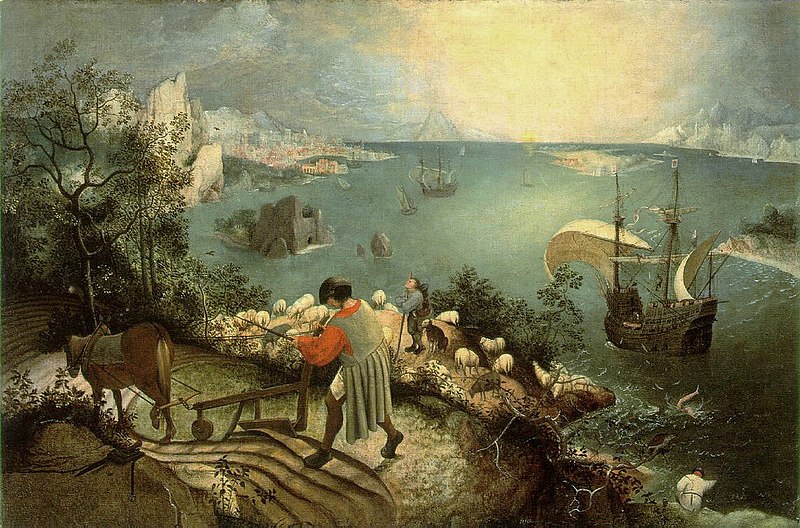
Something in the scene jumped out at me, and I recalled a recent blogpost by Roger Ebert: Why Are We Cruel?
One of the several worthy topics Mr. Ebert addresses in his essay is a style of painting that presents the unusual within the context of all the activity surrounding any event, with the effect that it may be hard to focus on and identify the remarkable. One example he gives is the painting, Landscape with the Fall of Icarus. Mr Ebert writes:
This is a theme found in another famous Bruegel painting, "The Fall of Icarus," concerning the legend of the young man who built wings and attempted to fly. He flew too close to the sun, which melted the wax in his wings, and he fell to his death in the sea.
This painting is a vast land and sea scape in which the titular event is simply one detail in the busy rush of life--two legs disappearing into the ocean, easy not to see. Bruegel's technique is in reaction to the tradition of narrative painting where the subject is the focus of attention. His painting shows the full sweep of Fleming society, of people and animals going about their daily affairs, most of them unaware of the great event that is taking place.

 You may not instantly notice Icarus falling into the sea - look in the bottom-right corner, or at the closeup on the right - and that's the point the artist is making. In general, remarkable moments are surrounded by (and may be obfuscated by) the swirl of the ordinary and routine around them.
You may not instantly notice Icarus falling into the sea - look in the bottom-right corner, or at the closeup on the right - and that's the point the artist is making. In general, remarkable moments are surrounded by (and may be obfuscated by) the swirl of the ordinary and routine around them.When I read Ebert's description and studied the painting it struck me how much the noteworthy is surrounded by the commonplace, and how difficult it is to separate the signal from the noise. My own takeaway is that I should strive to see the remarkable amid the frequent, and that I should place my own excitements into the perspective of all that is happening around me.
And so this afternoon, on a pretty day with fall foliage, I took the picture (excerpt below)

because as soon as I saw this view, I saw the remarkable amidst the common.
Here's a closer photo, and now you may see what I saw:

I've been taught (by my betters) to recognize a DC-9 by the distinctive Douglas nose, at about that distance (even without wings or tail). That's no BAC-111 or RJ, that's a DC-9, grandfather of the Boeing-717 (d/b/a the McBoeing).
I couldn't make out any registration on her, but I suspect she's a Series 15MC (Minimum Change, with folding seats which can be carried at the rear) or a Series 15RC (Rapid Change, with seats removable on pallets). From a different position:

How did a plane get on a train? Why were the wings removed? Had the airplane - really an airframe now, bereft of wings, tail, engines - been abused, twisted, corroded, burned?
The DC9 fuselage that fit so well on a railroad brings to mind the story of the space shuttle boosters and the width of a chariot team: specifications and bureaucracies live forever.
To me, the plane on the train was the small flash of the remarkable in a picture of the routine, just like Icarus' leg when it was still slightly out of the water.
Thank you, Mr. Ebert (via Infy).
 |  |  |
| the juxtaposition of Irish, beer, and cops is coincidental | ||



0 comments:
Post a Comment
Comments and Feedback? Love that stuff. Please leave your thoughts in the box below--